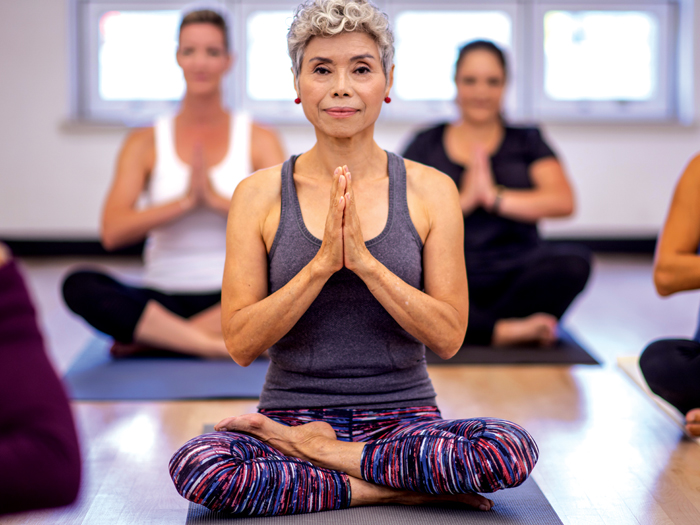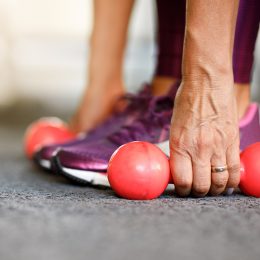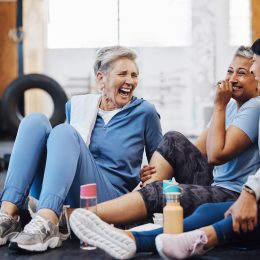Yoga for Seniors: Which Type Is Best for You?
From chair yoga to hatha to vinyasa, here’s your guide to eight popular yoga types every older adult should know.

There are countless reasons to add yoga to your routine. Research shows a regular practice not only improves balance and mobility in older adults, but it may also help ease back pain, relieve depression, and even reduce blood pressure for people with hypertension.
“Yoga can help keep the body agile,” says Terry Cockburn, a yoga instructor and owner of Freeport Yoga Company in Freeport, Maine. “It can also help you maintain proprioception, or the awareness of where your body is in relation to everything else,” she says.
That translates to a reduced risk of falls—which is especially compelling, considering falls are the leading cause of injuries in adults older than 65.
So, if you’ve considered trying yoga, now is the time to do it! You don’t have to be flexible or experienced to get started. To help you find the best class for your fitness level and personality, we break down eight of the most popular yoga types.
Getting Started Safely and Confidently
If you have a chronic condition, balance issues, or injuries, talk to your doctor about how you can exercise safely. For example, if you have osteoporosis, you can participate in yoga—but you may need to avoid forward bends and twists. But with proper medical guidance, even people who have previously fallen or been seriously injured can get stronger with yoga.
Then, keep in mind that teaching styles may vary between yoga classes and instructors, so it’s a good idea to call your local studio or fitness center before committing to a new class.
“Let them know what your concerns are, particularly if you have any health conditions,” says Sage Rountree, yoga instructor and coauthor of Lifelong Yoga. “They might steer you toward something that’s an even better fit for you than what you might choose for yourself.”
Yoga Style #1: Chair
Best for: Beginners, older adults, and individuals with chronic conditions, balance issues, or injuries
Can’t get down on the floor, don’t feel comfortable standing for long periods of time, or recovering from an injury that doesn’t allow you to do your usual activities? Chair yoga may be your answer.
A chair allows you to perform yoga poses while seated or helps support you while standing. Some classes may exclusively use chair poses, but many beginner-friendly classes may provide a chair and let you choose if you want to use it for some—or all—of the poses.
SilverSneakers Yoga, for example, offers a chair so you can perform a variety of seated and standing poses designed to increase flexibility, balance, and range of movement. You’ll also practice breathing and relaxation exercises to reduce stress. Classes are offered both in-person (find participating locations here) and online through SilverSneakers LIVE.
Check your SilverSneakers eligibility here. Already a member and looking for yoga options near you? It’s easy with the SilverSneakers GO app (free, iOS and Android).
Yoga Style #2: Restorative
Best for: Beginners, older athletes, and anyone recovering from an injury
Relaxation is key in restorative yoga, which is especially helpful for anyone recovering from an injury. Classes tend to focus more on stress relief than flowing from one pose to the next.
Expect to use props like yoga blocks, straps, and cushions to support your body in various standing and floor poses. You’ll hold postures for enough time to allow the mind to tune out and calm down.
“If you’ve never taken a restorative yoga class before, you might be surprised by how much tension your body is holding,” says Alison Heilig, a registered yoga teacher at Yoga Bliss Studios in Gaithersburg, Maryland.
“You realize your muscles are tense and doing stuff all the time,” she says. “And until you really have a chance to stay in one position and be supported, like in restorative yoga, you don’t feel them let go.”
Yoga Style #3: Yin
Best for: Beginners, older athletes, and people with muscle stiffness or balance issues
Similar to restorative classes, yin yoga is a slow-paced, meditative practice that gives your muscles a break and allows gravity to do the work during poses.
You can expect to breathe into one posture or stretch for several minutes, usually three to five, but some instructors may hold even longer. According to Cockburn, this targets the dense connective tissue in the body, which can get especially stiff in older adults.
Yin is a great option for beginners, older athletes, and anyone who spends a lot of time sitting or hunched over, Heilig says. “Because the poses are held longer, it’s an opportunity to really counter the positions that we hold throughout the rest of our life.”
Yin is also a great option for people with balance problems, since all poses are done on the floor.
Yoga Style #4: Hatha
Best for: All levels, including beginners who want a more dynamic practice
“Hatha” used to simply refer to the physical practice of yoga, but the definition has evolved over the past several years.
“The term is very much open for interpretation,” Cockburn says. “It can have various meanings depending on the studio and the instructor.”
In general, you can expect a hatha yoga class to be basic, slower movements that pair breathing exercises with postures. It’s more active than restorative yoga but less intense than vinyasa (more on that later).
Many hatha instructors expect they’ll get a mix of people coming into the class, Heilig says. “They have a bunch of different tools at their disposal to really help customize the practice for the people that are in the room.”
When in doubt, call the studio or fitness center to find out if their hatha class is appropriate for you.
Yoga Style #5: Iyengar
Best for: Beginners eager to learn and perfectionists
Iyengar yoga, named after and developed by B.K.S. Iyengar, is the practice of precision. Instructors encourage students to focus on proper alignment and feel each muscle’s role in every pose. As a result, you’ll hold poses much longer in Iyengar than many other yoga practices.
“I’m a big fan of this particular style for all ages, but particularly for someone who’s never done yoga before,” Cockburn says.
Unlike faster-paced yoga styles, Iyengar gives you the opportunity to learn the process of getting into a pose and how to use props—blocks, straps, blankets, or chairs—to support yourself in a position.
This type of yoga won’t count as a cardio workout, but you’ll definitely gain knowledge about your body and alignment.
Subscribe to our newsletter
It's quick and easy. You could be one of the 13 million people who are eligible.
Already a member? Click to discover our 15,000+ participating locations.
Follow Us
Yoga Style #6: Vinyasa
Best for: Intermediate or advanced yogis who want a heart-pumping workout
Vinyasa is one of the more vigorous styles of yoga. It’s a dynamic, flowing practice that focuses on connecting movement to breath, Rountree says. You usually don’t hold poses very long, about one or two breaths.
You can expect more cardiovascular and muscle-strengthening benefits from this style of yoga than many others. However, because vinyasa is fast-moving, it can be overwhelming if you’re not familiar with yoga basics. You probably won’t get many alignment cues or corrections from the instructor.
“If you’re somebody who wants to stay in the pose a little longer so you can make adjustments, a vinyasa class might not be right for you,” Heilig says.
Yoga Style #7: Ashtanga
Best for: Rule followers with some yoga experience
Ashtanga yoga is a style of vinyasa, but the key difference is ashtanga involves practicing the same series of poses every class and holding each pose for the same amount of time. There are several different ashtanga series, and you have to master one series before you can progress, Heilig says.
If you like structure and crave an athletic practice, this may be a good style for you. However, if you’ve never done yoga before, you might want to start with another style, like yin or hatha.
Similar to vinyasa, ashtanga classes tend to move quickly. Plus, the poses are often cued in Sanskrit, the language of ancient India, which can be challenging for a beginner to follow, Heilig says.
Yoga Style #8: Bikram
Best for: Fit individuals without health conditions and who like a lot of sweat
Similar to ashtanga, there are no surprises in a Bikram class. Each time, you’ll move through a 26-pose sequence and two breathing exercises, created by Bikram Choudhury.
But make no mistake: It’s a challenge. Every Bikram studio is heated to 105°F and 40 percent humidity. The idea is the heat increases flexibility and range of motion, helping you achieve a deeper stretch.
The caveat: It’s not for everyone. “It can be easy to overdo it in a hot room, either to overheat, get claustrophobic, or go beyond your own limits,” Rountree says.
The heat and intensity can increase the risk of dehydration and injury. The conditions, for example, can make the heart work harder, which can be problematic for anyone with heart disease or other health issues. Plus, classes last 90 minutes, which may be too long for some people.
If you’re new to Bikram, make sure to get the okay from your doctor first, and take it easy since your body may need to adjust, even if you’re very fit. Doesn’t sound appealing to you? No problem. With so many styles of yoga for a variety of fitness levels, you’re bound to find something that works for you.
Take Your Favorite SilverSneakers Classes Online!
SilverSneakers members can access live fitness classes and wellness workshops through SilverSneakers LIVE. See the latest schedule and RSVP for classes here.
Not a member? If you have a Medicare Plan, it may include SilverSneakers—at no additional cost. Check your eligibility instantly here.




